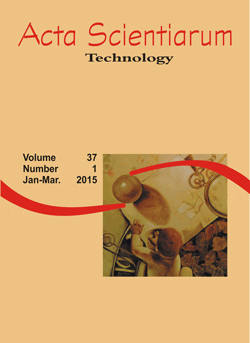<b>Assessment of antimicrobial activity of cinnamon (<i>Cinnamomum zeylanicum</i>) essential oil combined with EDTA and polyethylene glycol in yogurt
DOI:
https://doi.org/10.4025/actascitechnol.v37i1.17325Palavras-chave:
natural preservatives, microbial spoilage, dispersing agentsResumo
Essential oils (EOs) are technological options that may be employed in natural foods due to their antimicrobial activities. However, restrictions exist when high EOs concentrations are required which, in their turn, affect sensory qualities. Technological alternatives, such as combination of EOs with chelating and dispersing agents, have been proposed in the literature. Current research determined the antimicrobial activity of cinnamon EO against microbial spoilage in yogurt when added at the highest acceptable sensory EO concentration, alone or associated with ethylenediaminetetraacetic acid (EDTA) and/or polyethylene glycol. Cinnamon EO´s chemical analysis was performed by gas chromatography-mass spectrometry (GC-MS). Sensory analysis was conducted to define the highest acceptable sensory concentration of cinnamon EO in yogurt, stipulated at 0.04% cinnamon EO. Antimicrobial activity in yogurt was then evaluated for aerobic mesophiles, psychrotrophilic microorganisms, yeasts and molds counts. Treatments comprised (1) control, (2) 0.04% EO, (3) 0.04% EO + 0.01% EDTA, (4) 0.04% EO + 0.02% polyethylene glycol; (5) 0.04% EO + 0.01% EDTA + 0.2% polyethylene glycol, in triplicates. Concentration 0.04% of cinnamon EO, alone or associated with EDTA and/or polyethylene glycol, failed to show any antimicrobial activity against aerobic mesophiles, yeasts and molds.
Â
Downloads
Downloads
Publicado
Como Citar
Edição
Seção
Licença
DECLARAÇíO DE ORIGINALIDADE E DIREITOS AUTORAIS
Declaro que o presente artigo é original, não tendo sido submetido í publicação em qualquer outro periódico nacional ou internacional, quer seja em parte ou em sua totalidade.
Os direitos autorais pertencem exclusivamente aos autores. Os direitos de licenciamento utilizados pelo periódico é a licença Creative Commons Attribution 4.0 (CC BY 4.0): são permitidos o compartilhamento (cópia e distribuição do material em qualqer meio ou formato) e adaptação (remix, transformação e criação de material a partir do conteúdo assim licenciado para quaisquer fins, inclusive comerciais.
Recomenda-se a leitura desse link para maiores informações sobre o tema: fornecimento de créditos e referências de forma correta, entre outros detalhes cruciais para uso adequado do material licenciado.



















